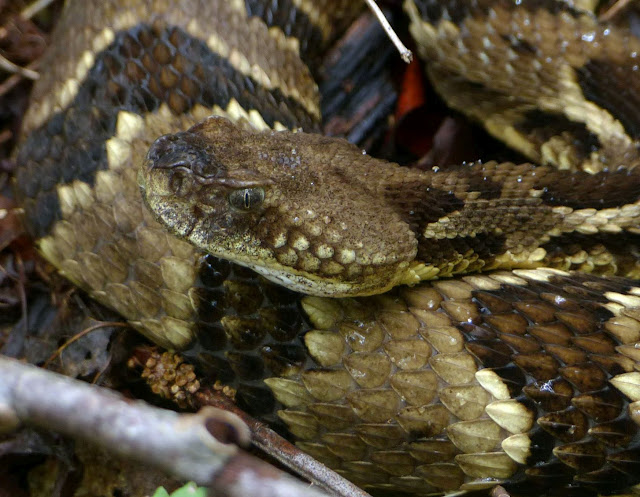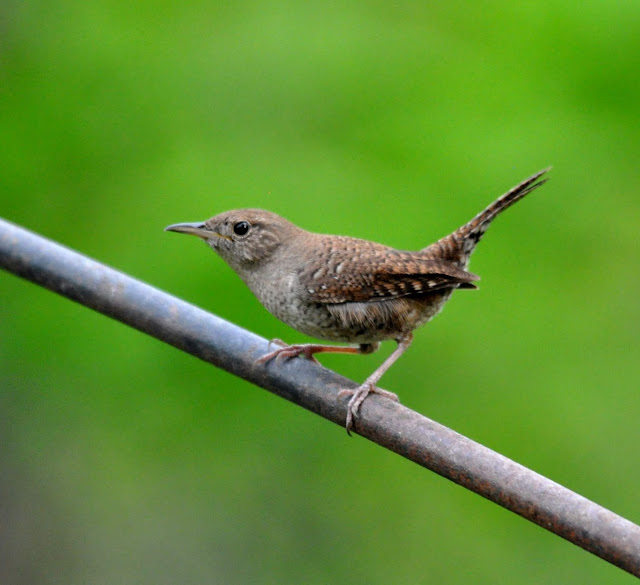For many years, the preserve has been searching and hoping that a state endangered timber rattlesnake,
Crotalus horridus, was living its long life on our property. As the preserve grows, and property to the east is purchased, we now own more land in the middle of suitable rattlesnake habitat. Locals have told tales of timber rattlesnakes crossing the roads near our property, and even a few pictures have been sent our way. We always assumed rattlesnakes were on our property, but we wanted proof. So the preserve put a lot of effort into finding rattlesnakes in 2019.
And after many hours searching, on July 26th, we finally found a rattlesnake!
The snake was found crossing a road, unfortunately one half mile from preserve property. But it was close enough that we thought we should catch it so the state wildlife biologist and herpetologist, Doug Wynn, could process it and decide if it was a suitable candidate for a transmitter. With a transmitter implanted inside it's body, we could monitor the movements of this snake and potentially find its den site, leading us to more rattlesnakes!
The snake was brought to the Eulett Center where Doug Wynn met and picked it up. Determining it was a male, he decided to take it home to surgically implant a transmitter.
After being anesthetized, Doug placed a transmitter under the snake's skin. This device will produce an audible signal for about 3 years. With this implant, we can follow this snake long enough to learn its habits.
 |
| Transmitter with antenna (Photo by Doug Wynn) |
 |
| Transmitter inside snake's body (Photo by Doug Wynn) |
The rattlesnake recovered well, and was ready for release on August 5th. Released in the same spot it was captured, it instantly moved up a hill and into a hole under a rotting tree stump on the side of the road.
 |
| Timber rattlesnake making its escape. |
 |
| Rattlesnake moving towards tree stump (Photo by Robyn-Wright Strauss) |
 |
| Rattlesnake entered hole, little did we know that its head went in first, but came right back out while rattle was still out. |
For the next 2 months, our job was to follow this snake and cross our fingers that it ends up spending most of its time on the protected lands of the Edge.
 |
| (Photo by: Rich McCarty) |
The day after release, the snake moved about .3 miles uphill, and surprisingly, towards our property! By day 3, it had entered Edge property and was easily located using antenna and receiver which picks up the beeps from the transmitter.
We then tracked the snake over the next month which moved 1.7 miles in one direction before settling down on a south facing slope of the preserve.
 |
| Notice the person in the middle of the picture, deep in brush listening to beeps of the rattlesnake. (Photo by: Rich McCarty) |
The area it has settled was not a friendly piece of land. The steep slopes were full of thorn laden Rubus sp. and greenbrier vines that not only made it difficult to walk, but difficult to see a snake on the ground. Not to mention, this snake could ruin your day if you stepped on it.
 |
| It is not easy to see the snake on the ground. There is a rattlesnake pictured above.....but where. (Photo by: Rich McCarty) |
 |
| This is how we typically found the snake. It sits still in this position never moving, no matter how close we may have been. (Photo by: Rich McCarty) |
Below is a video with some rattlesnake encounters.
By the end of September, the snake had left the south facing hillside and the beep from its transmitter was gone. The chase was on to relocate the snake and hope it was still on our property as winter approaches, and it should be headed to its den soon.
Unbelievably, we re-found the beep, and the snake had moved all the way back to the exact spot it was found on day 3 after release! It was within feet of where we had already once found it. It hung around this hillside for weeks, then on Oct 14, the transmitter had done its job. It led us to its hibernaculum where it will spend the winter underground. By the way, it was still on preserve property!
 |
| We would not have guessed that these small holes in the ground that go under a piece of sandstone would be a den entrance. |
John Howard put a camera on the entrance to the den site so we could monitor anything coming in or out of it. The video below shows some time lapsed photos of the snakes using the hibernaculum. To our surprise, our rattlesnake was not the only rattlesnake using the hole in the ground. A second rattlesnake was in there, along with some black racers and a copperhead who visited one night too. This video was put together by John, and watching the center of the screen, you can see snakes going in and out.
This teamed effort has helped us learn so much about this rattlesnake in such a short amount of time. The hard part was catching a rattlesnake. But after the transmitter was implanted, the snake led us on an interesting chase. We now know exactly where it traveled, how long it stayed in each place, where is hibernaculum is, what else is sharing it, whether or not it comes out to bask in the sun once inside and come next spring, we will learn so much more. Thanks to Doug Wynn, John Howard and Vince Howard for assisting the preserve on the wild hunt and chase this snake has afforded.
Now we wait until spring and find out when the snakes come out of the den and what path our transmitted snake will travel in 2020.
Posted by: Mark Zloba































































